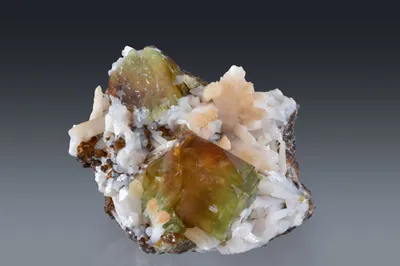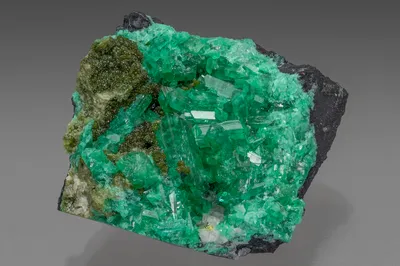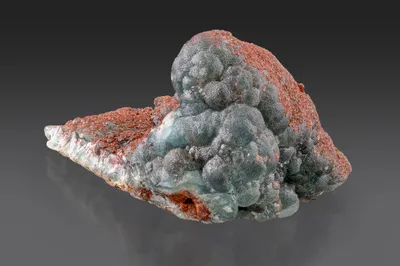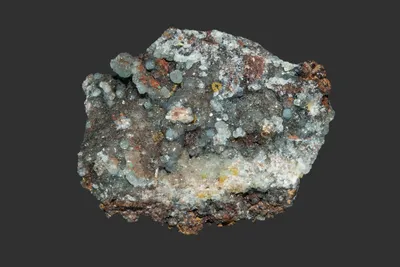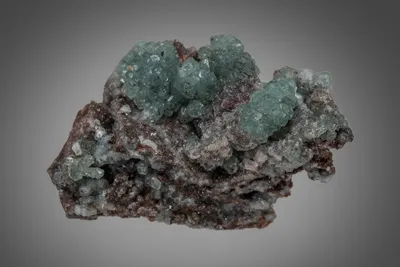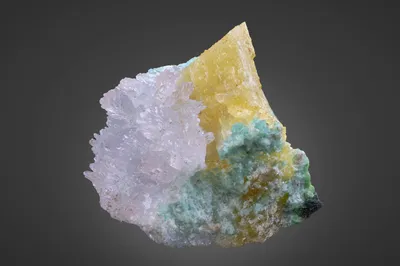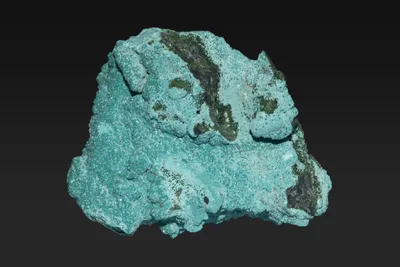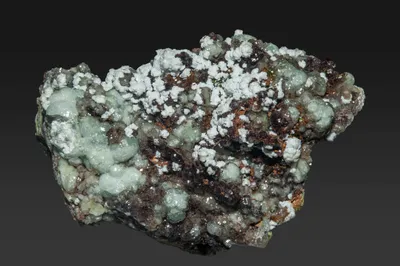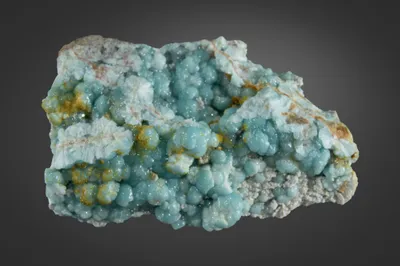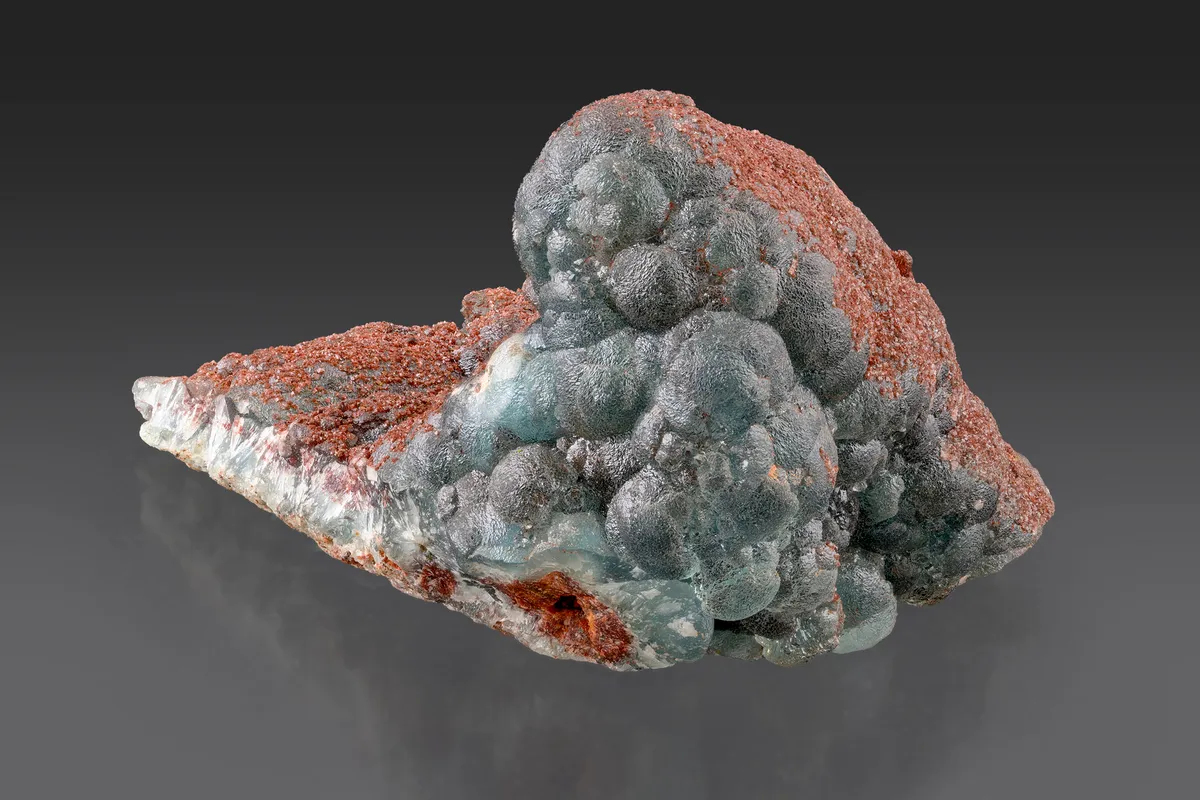
Image Credit: Malcolm Southwood
Mineral Species
Willemite
Type Locality
No
Composition
Zn2SiO4
Crystal System
Trigonal
Status at Tsumeb
Confirmed
Abundance
Common
Distribution
First, second and third oxidation zones
Paragenesis
Supergene
Entry Number
Species; TSNB371
General Notes
Willemite was encountered quite early in the mine's history, high in the first oxidation zone. It was not mentioned by Maucher (1908a) but Gebhard (1999; page 232) figured a specimen recovered in 1915 of willemite forming an epimorphous replacement after mimetite and then partly overgrown by smithsonite; he noted, however, that early observers failed to recognise the willemite.
Klein (1938) makes no mention of willemite and, perhaps more significantly, there are no examples of willemite listed in his collection catalogue (unpublished; Klein family archive). Neither is willemite represented among the Karabacek Collection specimens at Harvard.
Strunz et al. (1958a) included willemite in their lists of minerals occurring in both the first and second oxidation zones. Nevertheless, the scant documentation and paucity of willemite specimens in pre-WWII collections imply that willemite was uncommon in the first oxidation zone.
Strunz and Tennyson (1967) offered the first informative description of willemite from Tsumeb. They merely noted its presence in the upper levels of the mine before going on to describe willemite from the second oxidation zone as "… white, grey and yellow crystals and aggregates consisting of rounded forms [and] fine fibrous white crusts."
Geier (1973/1974) considered the occurrence of willemite in the second oxidation zone particularly noteworthy, given the near absence of zinc silicates in the first oxidation zone. He described both massive and well crystallised habits of yellow, green and blue willemite and noted the occurrence of brown-pink troostite in which he noted the high manganese content. He also observed that Tsumeb willemite is characteristically fluorescent under ultraviolet radiation.
Bartelke (1976) observed that willemite is found as well-developed crystals but also as massive radiating crusts. Crystals range from short prismatic to acicular, with the latter often forming radiating clusters or "crystal lawns". The colour ranges from colourless-white, through yellow, turquoise and blue to grey. Brown willemite, known by the varietal name of troostite is coloured by manganese according to Bartelke (1976), although Keller (1984) considered that brown willemite is coloured by hematite inclusions.
Pinch and Wilson (1977) noted that:
"Willemite has been found in attractive blue, green, yellow and gray translucent crusts and also as well-formed hexagonal crystals of various colors including white, yellow, turquoise-blue, blue and gray. The habit of the crystals varies from short prismatic terminated by the pinacoid to long prismatic with pyramidal faces."
Minerals commonly associated with willemite are cerussite, dolomite, duftite, malachite, mimetite and rosasite.
Keller (1977a) placed willemite in one of his "Type I" paragenetic sequences (i.e., minerals forming under near-neutral pH conditions. Two generations of willemite are observed in this paragenesis:
I/6: [willemite(i) + smithsonite(i)] >> [rosasite + duftite] OR mimetite >> willemite(ii) >> cerussite >> smithsonite(ii)
Wilson (1981) described pseudomorphs of willemite after azurite which, on closer inspection, appear to be dolomite epimorphs after azurite on which willemite has subsequently crystallised. According to the original Mineral Kingdom (Zweibel) labels for these pseudomorphs they were collected on 29 Level in the second oxidation zone.
Gebhard and Schlüter (1995) described lemon-yellow willemite from 44 Level in the third oxidation zone. Individual crystals to 10 mm are fused into composite aggregates to 30 mm in length resembling warikahnite (for which they were initially mistaken). The yellow willemite is associated with yellow-green conichalcite and colourless, acicular smithsonite but combinations with zincolivenite and rosasite were also found. Gebhard (1999) added that these yellow willemites were found "… on the deepest levels from the 43 to 46 levels".
Yellow willemite at Tsumeb is quite rare and often referred to as "cadmian willemite" on the assumption that cadmium, presumably as inclusions of cadmium sulphide, is the cause of the yellow colour. While this varietal name remains in popular use it is strongly discouraged by the IMA’s guidelines on nomenclature and should be considered obsolete.
According to Gebhard (1999) "… white bundles of needles are the most common habit [for willemite]", followed by spheroidal aggregates of crystals. Radial aggregates of willemite crystals, typically with gently curved surfaces or a botryoidal habit and commonly green or blue-green in colour are also quite common. The finest specimens, however, consist of gemmy blue willemite crystals, to 10 mm, on white calcite. Unfortunately, Gebhard provided no indication of the location in the mine at which these specimens were found, but they are also described by Key (1977) and are believed to have been collected in the early 1970s.
Inexplicably, Gebhard (1999) stated that "… unlike other occurrences, Tsumeb willemite is not fluorescent under ultraviolet radiation." Von Bezing et al. (2014) pointed out that this is incorrect and that "With newer generation UV-SW equipment, virtually all specimens fluoresce with a variable intensity, from yellow to green."
Pohwat (2015a) described the variety of willemite habits and colours from Tsumeb and figured a number of diverse willemite specimens from Tsumeb (and from other localities).
Moore (2016) pointed out that good specimens of willemite were found at "… infrequent intervals throughout the life of the mine …". He summarised the variety of specimens as follows:
"The specimen styles are highly varied: from sprays of acicular crystals to shining spherical aggregates to sharp individual crystals to more than 1 cm. Colors vary from yellow to reddish brown to a beautiful bluish green. Perhaps most common, though never really plentiful on the specimen market through the decades have been mammillary surfaces composed of lustrous, translucent blue-green spheres of tiny crystals, which may be associated with crystals of numerous other Tsumeb species."
Associated Minerals
adamite; alamosite; anglesite; aragonite; arsendescloizite; arsenohopeite; azurite; calcite; cerussite; chrysocolla; conichalcite; dioptase; dolomite; duftite; fraipontite; gebhardite; goethite; helmutwinklerite; hematite; hemimorphite; hörnesite; hydrozincite; kasolite; kegelite; koritnigite; köttigite; larsenite; leadhillite; maghemite; malachite; mathewrogersite; melanotekite; mimetite; minrecordite; mottramite; plancheite; plumbotsumite; pyrolusite; quartz; queitite; rosasite; skorpionite (?); smithsonite; surite (?); tsumcorite; wulfenite; zharchikhite; zincolivenite
Pseudomorphs
Willemite is reported to form pseudomorphs after the following minerals: azurite (rare); cerussite (rare); mimetite (rare).

